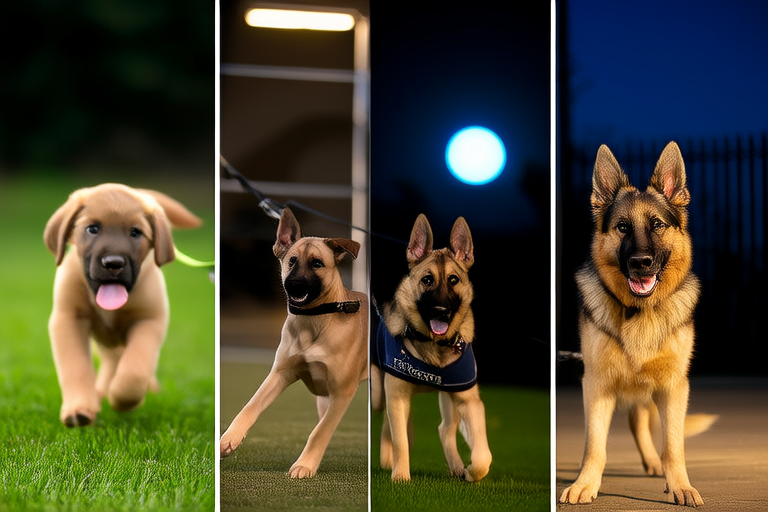From Puppy to Protector: The Journey of a German Shepherd
The journey from a playful puppy to a steadfast protector is a remarkable transformation that every German Shepherd undergoes. This breed, known for its intelligence, loyalty, and versatility, has been a cornerstone of many families and professions around the world. Let us delve into the early life, training phases, developmental milestones, and the diverse roles these dogs play in society.
Early Life and Training Phases
A German Shepherd’s life begins in a litter of puppies, usually born between six and eight weeks. These puppies are born with their eyes closed and rely on their mother and siblings for warmth and nourishment. By the time they open their eyes at about two weeks old, they start exploring their surroundings with increasing curiosity.
At around three weeks, the puppies begin to walk and engage in playful activities, developing their coordination and social skills. During this period, it is crucial for the breeder to provide a nurturing environment that encourages exploration and interaction. Around six weeks, the puppies are ready to leave their mother and start living with their new families.
The initial stages of training focus on socialization and basic commands. Puppies learn to respond to their names, sit, stay, and come when called. Positive reinforcement techniques, such as treats and praise, are essential during this phase. Around four months, German Shepherds enter their adolescent stage, characterized by increased energy and sometimes challenging behavior. Consistent training and patience are necessary to guide them through this phase.
As the dogs mature, they can begin specialized training for various roles, including protection, search and rescue, or service work. For example, police dogs undergo rigorous training to develop their protective instincts and obedience. They learn to apprehend suspects, locate missing persons, and assist in crime scene investigations. Meanwhile, service dogs are trained to assist individuals with disabilities, providing support and companionship.
Developmental Milestones
German Shepherds reach sexual maturity at around one year old. However, their physical and mental maturity takes longer, typically reaching full development by the age of two to three years. During this period, they experience significant growth in muscle mass, bone density, and cognitive abilities. Their intelligence becomes more apparent as they demonstrate problem-solving skills and adaptability in various situations.
One of the most notable milestones is the development of their protective instincts. German Shepherds have a natural predisposition to guard their territory and family. This trait makes them excellent candidates for roles such as police officers’ partners, military dogs, and personal protectors. Their loyalty and dedication to their handlers are unmatched, forming a deep bond that is both emotionally fulfilling and professionally effective.
Intelligence, Loyalty, and Versatility
German Shepherds rank among the top breeds for intelligence, according to Stanley Coren’s book “The Intelligence of Dogs.” Their ability to learn new tasks quickly and apply problem-solving skills makes them highly versatile. In addition to protection and service roles, they excel in agility competitions, therapy work, and as family pets. Their loyalty and devotion to their owners are legendary, often forming lifelong bonds.
Real-life examples of German Shepherds as protectors include Max, a police dog who saved his handler’s life by alerting him to an approaching vehicle while on patrol. Another example is Diesel, a search and rescue dog who located survivors after a devastating earthquake. These stories highlight the breed’s unwavering commitment to their duties and the lives they save.
Maintaining a Strong Bond
To maintain a strong bond with your German Shepherd, it is essential to provide consistent training, affection, and mental stimulation. Regular exercise, such as walks, runs, and playtime, helps keep them physically fit and mentally engaged. Additionally, offering puzzle toys and interactive games can stimulate their minds and prevent boredom.
Building trust and communication is crucial in maintaining a strong bond. Spend quality time with your dog, engaging in activities they enjoy and praising them for good behavior. Positive reinforcement techniques, such as treats and verbal praise, can strengthen the connection and encourage desired behaviors.
In conclusion, the journey from puppy to protector is a testament to the German Shepherd’s remarkable qualities. From their early life and training phases to their developmental milestones and diverse roles, these dogs consistently demonstrate intelligence, loyalty, and versatility. Real-life examples of German Shepherds as protectors, service animals, and companions illustrate the profound impact they have on our lives. By fostering a strong bond through consistent training, affection, and mental stimulation, we can ensure a lifetime of happiness and fulfillment for our beloved German Shepherds.
